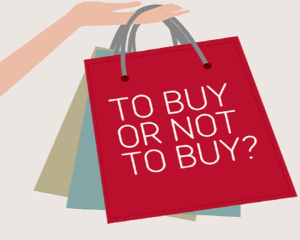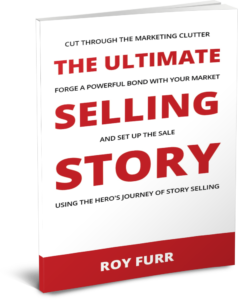 What controls our buying decisions?
What controls our buying decisions?
Why do we decide to buy one product over another? Why do we choose to make a purchase today, when we’ve held off for the last three months? What moves us to finally say yes once we’ve heard the 14th reason we should get something?
The short answer is: buying criteria.
Once we have a certain set of buying criteria laid out — AND we realize a product or service meets those criteria — we make our decision and buy.
If you make your living through persuasion — copywriting, marketing, selling — you absolutely must understand this.
Because once you understand buying criteria, you have two incredibly powerful tools to help you sell better…
Your first most obvious tool is your ability to meet your customer’s buying criteria…
If you can figure out why a prospect wants to buy, and your offer fulfills their reasons, you have an easy way to sell.
You simply have to present your offer in a compelling way that shows your prospect that you can meet their needs.
Let’s say someone is buying a set of headphones.
They want a certain type, such as ear buds.
They care about bass in their music, so they need a frequency response down in the 20 to 50 Hz range.
They want them to be Bluetooth.
And they want them to be a certain color.
That’s a pretty simple list, for a pretty straightforward physical product.
But it might be the kinds of things I’m looking for in my next set of headphones.
If I’m the marketer and I’m marketing to someone with this set of buying criteria, I want to make sure all of these things are clearly laid out in my marketing.
Perhaps with a whole pile of testimonials that reinforce customer satisfaction on all these criteria. Testimonials about the bass and general sound quality. Testimonials about the quality of the Bluetooth connection. And so on.
This is simple, and represents a minimum threshold for persuasion.
And it’s especially useful to stay on top of if you sell products with obvious and comparable attributes, such as headphones.
But there’s another level of persuasion that goes far beyond this…
Your second — and more powerful — tool is the ability to shape buying criteria…
Although I underplayed it in my book, The Ultimate Selling Story, that’s what that book was all about.
 The very act of meeting someone’s buying criteria implies that they’re already very aware of at least the potential in a solution, for whatever problem they’re looking to have solved.
The very act of meeting someone’s buying criteria implies that they’re already very aware of at least the potential in a solution, for whatever problem they’re looking to have solved.
This solution-aware segment of the market is only a sliver of the potential.
The much bigger market are those who are not aware yet of much more than the fact that they have a problem they want to have solved.
Or, perhaps, they’re simply becoming aware of an irritation in their life, without even fully understanding the problem.
Before someone starts to establish buying criteria, they have to clearly define an ideal solution.
And before that, they have to invalidate their previous course of action in dealing with the problem.
And before that, they have to be agitated enough about the problem to want to do anything.
And before that, they have to become aware of the problem.
So let’s look to the most unaware prospect, just as they’re starting to realize that something is bugging them that might need their attention.
Here’s what happens before a prospect even considers buying criteria…
It starts that they realize there’s a problem growing in their life.
Then, as they recognize the problem, it grows in agitation.
They may try some band-aid level fixes, or simply dealing with it.
But the agitation continues to grow, and they realize whatever half-cocked solutions they’ve been trying are invalid.
So they look around at potential solutions.
They start to compare what’s out there.
They look at options.
And before they buy anything, they develop the buying criteria they will use to make their decisions.
Here’s what you must do to get them to buy from you…
You absolutely need to understand the buying criteria that favors your product. Determine what your market is looking for, and have persuasive messages in place that favor your product.
But don’t lead with that — because you’ll only grab that small sliver of buyers who are coming with criteria in hand that already favor you.
Rather, you want to catch them much earlier.
Figure out how to capture the attention of your market at the point where they’re realizing they have a problem.
Then, walk them through the awareness process.
Help them define the problem. Help them see the current agitation it’s causing, and the future agitation they’ll experience if they don’t deal with it.
And here comes your magic moment…
Lay out the reasons why other approaches they’ll try (including other types of products) are invalid.
Through showing why other approaches are invalid, help them establish a set of buying criteria for the best possible solution.
Help them see clearly why they’re having the problem, and why they need a product or service that does X, Y, and Z to end the problem for good.
Then, once you’ve helped them come to a certain set of buying criteria, show how your offer is the solution because it meets those buying criteria.
This is based on a fundamental truth of human nature…
We are constantly looking for shortcuts.
We’re constantly looking for ways to NOT think about things.
We want help.
We want someone else to have done the work.
And so we look for leadership.
If I have a problem, I could put in tremendous work and mental effort to solve it.
Or, I can look to others who have solved it and benefit from their experience.
As a default, we look to others.
As a marketer, you can use this. Ethically, mind you.
Simply identify why your product or service is truly and ideal solution. Outline the buying criteria that favors your product as the best. And then use the process above to explain how you got there.
Even better, do it all in the form of a story, as I lay out in The Ultimate Selling Story.
Yours for bigger breakthroughs,
Roy Furr



